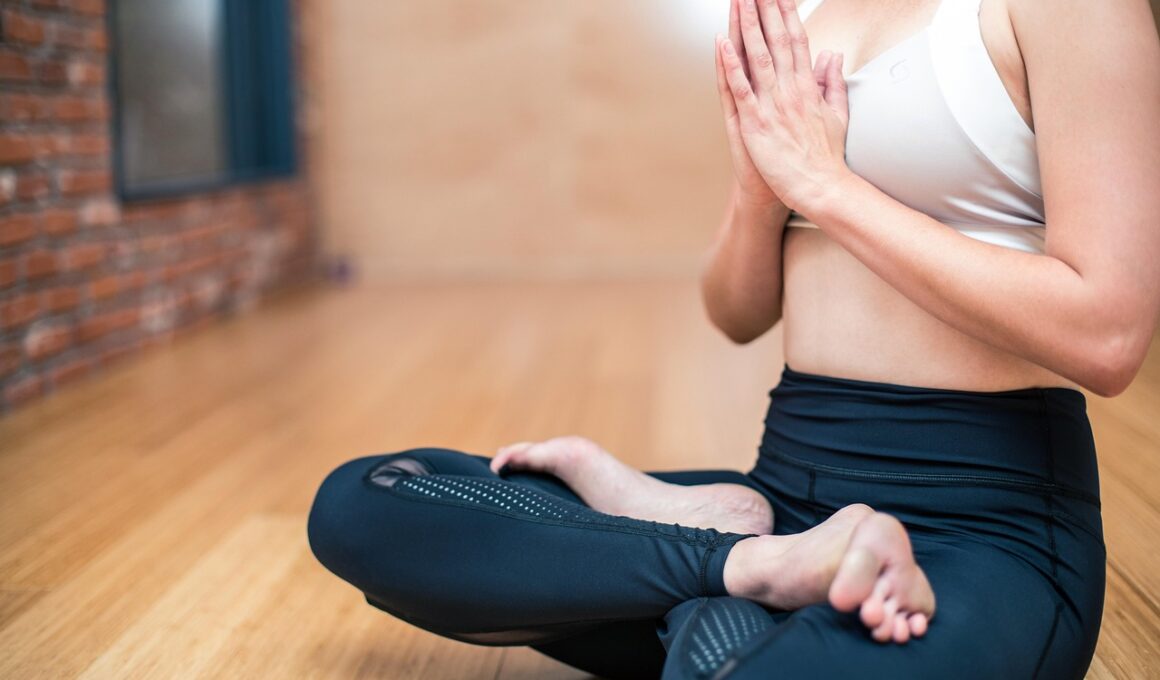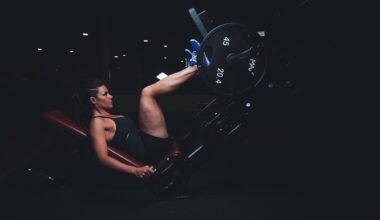Postural Exercises to Improve Lung Function
Postural exercises are vital in enhancing lung function, especially for individuals with chronic respiratory diseases. These exercises focus on correcting poor posture, which can significantly impact breathing efficiency and lung health. When the spine is aligned properly, the rib cage can expand fully, allowing optimal lung capacity. Additionally, good posture can alleviate pressure on the diaphragm, enabling better airflow. Incorporating exercises that strengthen the core and promote proper alignment can lead to substantial benefits in lung function. Various techniques are available, ranging from specific stretching routines to strength-building activities. Engaging in postural exercises helps create awareness of body mechanics and breathing patterns, both essential for improved lung performance. Moreover, individuals can practice simple activities that encourage proper alignment and relaxation. Some common postural exercises include seated and standing stretches, as well as yoga-inspired techniques. Ultimately, focusing on posture is a practical approach for individuals looking to enhance their respiratory health and overall wellbeing. A dedicated routine that incorporates postural exercises can yield lasting results, making it an essential aspect of lung function improvement for those with chronic respiratory conditions.
The Importance of Breathing Mechanics
Understanding how mechanics of breathing work is crucial for enhancing lung function. The diaphragm, intercostal muscles, and other respiratory muscles play critical roles when we breathe. Many people, especially those with chronic respiratory conditions, often fail to use these muscles effectively. Poor breathing mechanics often stem from slouching or hunching, which restricts airflow and reduces oxygen intake. Thus, postural exercises can help retrain the body to utilize these muscles more effectively. When the chest is open and the spine is straight, the diaphragm can contract and relax better, which maximizes lung capacity. Furthermore, practicing breathing techniques such as diaphragmatic and pursed-lip breathing can significantly improve lung function as well. Engaging in structured exercise programs that include postural awareness not only enhances physical fitness but also contributes to better respiratory health. Regular practice of these exercises can help those with chronic respiratory diseases breathe easier and feel more energized. Consequently, targeting breathing mechanics through these postural exercises offers a sustainable way to promote lung health. Long-term benefits can include reduced symptoms and improved quality of life for those living with chronic respiratory issues.
Incorporating postural exercises into daily routines is essential for those living with chronic respiratory diseases. Simple practices like maintaining an upright position while sitting or standing can make a significant difference. Regularly checking in on one’s posture can cultivate better breathing habits and enhance lung function over time. Additionally, specific exercises targeting the upper back and shoulders can promote strength and flexibility, ensuring the chest opens fully during breathing. Activities such as thoracic extension exercises encourage proper posture while supporting recovery from respiratory illnesses. Furthermore, individuals might consider utilizing props like yoga blocks or balls to reinforce proper alignment and support during exercises. Joining a fitness class or working with a physical therapist familiar with respiratory health can provide personalized guidance. These exercises should fit within a comprehensive health and fitness regimen to ensure the best results. Moreover, individuals are encouraged to incorporate deep breathing sessions into their daily practices. Combining these methods can foster a powerful synergy between posture and respiratory function, markedly benefiting individuals with chronic respiratory conditions. Regularly practicing these postural exercises can empower individuals to take control of their lung health.
Best Postural Exercises for Lung Improvement
Several effective postural exercises can significantly benefit lung function for individuals living with chronic respiratory diseases. One of the most beneficial is the thoracic stretch, which helps open the chest and improve lung capacity. To perform it, individuals should stand with feet shoulder-width apart and clasp their hands behind their back. Gently pull the shoulder blades together while lifting the arms to enhance thoracic expansion. Another valuable exercise is the seated twist, which helps improve spinal flexibility and posture. Sitting upright, one can twist their torso gently to either side while focusing on deep, controlled breaths. Additionally, the cat-cow stretch promotes spinal mobility while promoting relaxation in the diaphragm. This can be done on all fours, alternating between arching and rounding the back while engaging in deep breathing. Furthermore, resistance band exercises targeting back and shoulder muscles can enhance posture significantly. These activities build strength and awareness to ensure proper alignment is maintained throughout various daily activities. Lastly, practicing sustained deep breathing during these exercises can engage and strengthen respiratory muscles, ensuring they function efficiently. These practices collectively contribute to better lung function, improving quality of life for individuals affected by chronic respiratory issues.
Individuals with chronic respiratory diseases can achieve immense benefits through consistent practice of postural exercises. Developing a structured routine is crucial for long-term success and improvement. First, it is essential to allocate time daily to engage in these beneficial workouts. Consistency is key, and even short, focused sessions can yield significant results over time. Pairing these exercises with other forms of physical activity can enhance overall fitness. In addition to strengthening respiratory muscles, postural exercises contribute to better cardiovascular health. Staying active promotes blood circulation, delivering oxygen-rich blood to vital organs, including the lungs. Maintaining good hydration and a proper diet will further augment the positive effects of these exercises on lung function. Moreover, engaging in social settings such as fitness classes encourages accountability and motivation, which can help maintain a regular practice. Some individuals may consider tracking their progress through logs or wearable technology. Celebrating small victories can boost confidence and adherence. Ultimately, embracing a lifestyle centered on physical activity, healthy eating, and good posture offers a comprehensive strategy for managing chronic respiratory diseases effectively. This holistic approach focuses on enhancing lung function while enriching the quality of life for individuals affected.
Monitoring Progress and Adjustments
Monitoring progress is vital when engaging in postural exercises for lung function improvement. By keeping track of improvements and setbacks, individuals can make necessary adjustments to their routines. It is advisable to maintain records detailing personal goals and milestones achieved over time. Regular assessments can serve as valuable feedback on the effectiveness of the exercises. Individuals may notice enhanced lung capacity or improved endurance during physical activities. If deficiencies appear, a reevaluation of technique and frequency may be necessary. Seeking guidance from healthcare professionals or fitness trainers can provide essential help. This expert input can assist with fine-tuning techniques to suit individual needs. Online resources can offer various tutorials and support systems to bolster learning. Furthermore, incorporating different variations of postural exercises can keep routines enjoyable and engaging. When individuals find satisfaction in their practice, they are more likely to remain committed. Additionally, setting new goals can foster ongoing motivation and growth in lung function. Through continuous monitoring and adapting routines, individuals can derive lasting benefits geared towards improving their lung capacity and overall health.
The journey towards enhanced lung function through postural exercises requires patience and determination. It is essential to approach these exercises with a mindset focusing on gradual improvement rather than instant results. Individuals should remember that making lifestyle changes takes time and consistent effort. Therefore, integrating these exercises into daily life should encompass a long-term view. Achievements may be small at first, but over time they can culminate in remarkable progress. Additionally, cultivating a supportive environment can strengthen the motivation to succeed. Encouraging family members or friends to join the practice can enhance accountability and foster companionship within exercise routines. Furthermore, exploring local communities or online forums dedicated to respiratory health can provide valuable resources and support systems. Engaging with others facing similar challenges can create a sense of belonging and shared understanding. Lastly, individuals are encouraged to incorporate mindfulness practices alongside their exercise routines. This can further enrich the overall experience by promoting mental wellbeing while fostering the determination needed for consistency. Staying committed to enhancing lung function through effective postural exercises can promote a healthier, more vibrant life for individuals with chronic respiratory diseases.
Conclusion
In conclusion, postural exercises serve as a powerful tool to enhance lung function for individuals living with chronic respiratory diseases. It focuses on correcting posture while promoting awareness of breathing mechanics. This integration improves airflow and oxygen intake significantly. Engaging in these exercises regularly can develop strength and flexibility in respiratory muscles. Furthermore, these exercises empower individuals to take control of their respiratory health actively. A structured fitness routine centered on correct posture provides lasting benefits, improving the overall quality of life. Monitoring progress and adjusting approaches ensures achievements along the journey of enhancement. Creating a community of support can offer additional encouragement, making the journey even more fruitful. Lastly, understanding that improvement may take time encourages patience among practitioners. As individuals continue to invest effort into developing their lung function, they can experience physical and mental health benefits. Ultimately, postural exercises can foster empowerment and resilience, enabling them to combat the challenges chronic respiratory diseases present. A holistic approach involving exercise, awareness, and support leads to more vibrant health outcomes long-term for those affected by chronic respiratory illnesses.


